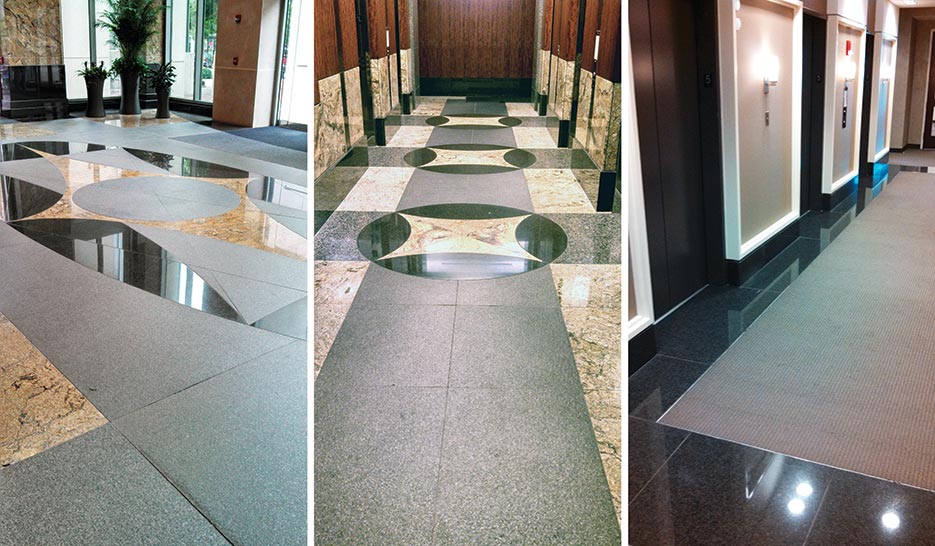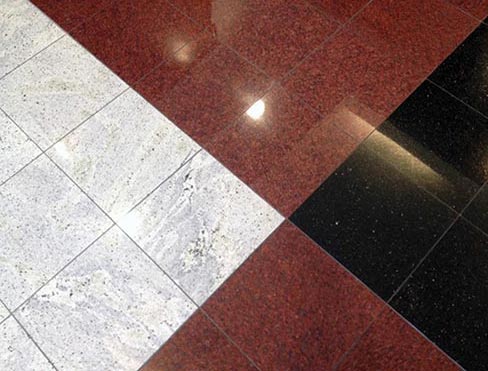Proper Natural Stone Selection and Applied Engineering
Bob Murrell
Special Contributor
(Hover over photos to see captions)
Natural stone, including polished marble and granite, are chosen for the upscale image that stone is associated with.
Add to that the fact that natural stone is also one of the most desired building materials, and the choice becomes simple. Those property owners and architects who want to convey beauty, style, uniqueness, strength, and longevity will choose natural stone every time.

There are many varieties, when selecting a natural stone or stones. Some say that there are over 9,000 types of natural stone of which some half are used in the dimensional stone industry today. Most stone is chosen for aesthetic value alone and not the applicability. This is unfortunate as the maintenance and restoration of the material could be performed much more efficiently had the stone been chosen more carefully. In some cases a bad choice of material has actually inhibited the proper maintenance and/or restoration of a project creating large, expensive problems.
The different properties of natural stone that are of major concern are strength and hardness, color and color characteristics, chemical resistance, abrasion resistance, ease of maintenance and restoration, surface appearance, and there are many others.
 Granites are usually stronger, more chemically resistant, and more abrasion resistant than marbles. Polished surfaces require more maintenance than honed or textured surfaces. Marbles, typically, have more color variation than do granites. All of these issues must be addressed when selecting an appropriate natural stone for a specific application.
Granites are usually stronger, more chemically resistant, and more abrasion resistant than marbles. Polished surfaces require more maintenance than honed or textured surfaces. Marbles, typically, have more color variation than do granites. All of these issues must be addressed when selecting an appropriate natural stone for a specific application.
To make matters worse, when stones that are not compatible from a maintenance or restoration aspect are installed together, it can be a disaster. Not to mention the fact that stone is also installed with other non-compatible materials such as wood, carpet, and ceramic tile.
So what can be done to avoid these problems and still reap the benefits of installing natural stone? Do the research. Check with several stone suppliers, independent consultants, and qualified stone maintenance and restoration companies for advice on proper material selection. Try to design a Smart Installation with long-term maintenance as well as restoration in mind. Make sure that the team of professionals you select understands that this is the number 1 priority goal of the installation. All other aspects of the installation should be based on this premise.
Smart Installations are designed with both function and artistic flair in mind. Commercial bars and countertops are routinely exposed to chemical attack from acids, solvents, and alkalis. Polished granite can give us the high gloss look in a variety of colors while it is also very resistant to most chemicals. Storefronts use the beauty of highly ornate polished marble with all of its natural veining to convey style and fashion.
Honed limestones, marbles, and granites are very popular in large, high traffic applications such as malls. Honed surfaces are very smooth but have little or no light reflection. Foot traffic can actually be equated to a grit like sandpaper. Foot traffic is somewhere between a 200 grit and 400 grit abrasion factor. The stone is honed at the factory to either 220 grit or 400 grit. Therefore, the foot traffic abrasion actually maintains the stone’s surface. With polished flooring materials, it is a constant battle to maintain the high gloss appearance. For this reason, honed materials are becoming increasingly popular here in the USA. Europeans have known this for hundreds of years.
When it is decided that a highly polished floor is desired, use of a harder material is recommended. Also, darker stones show wear patterns and scratches faster than do lighter materials. In this situation, a light-colored granite may be advisable. The polish on granite will normally last longer than that of marble. On the other hand, marble is usually easier and less expensive to restore than is granite. If the installation has less foot traffic, marble may be the preferred choice.
Combining marble with granite may cause problems in that the two materials are restored with different abrasives and/or techniques even though maintenance procedures may be similar. The same holds true of materials with different surface finishes, such as flamed granite and polished marble. These types of problems are reflected in the price of a restoration project. As the difficulty increases, so does the cost.
Restoration is an inevitable fact of most natural stone installations. This is one of the best properties natural stone possesses, the fact that it is restorable many times over. It is imperative to design a natural stone installation with future restoration in mind. A floor that has been restored properly is worth much more than a newly installed floor. The reasons are many. Restored stone installations, which have been ground flat, will be easier and more effectively cleaned. The installation will have a much better appearance and will have fewer trip hazards. Most stone floors in Europe are ground flat as part of the installation.
To sum up, do the necessary research before installing natural stone. Color schemes and patterns can be accommodated without sacrificing function and Smart Design. Check with reputable professionals about what materials are right for your installation before the project starts.
Bob Murrell has worked as a supplier of products and technical support to the natural stone industry for over 35 years. He has written numerous articles for various trade publications and has also trained thousands of contractors over the last 25 years.